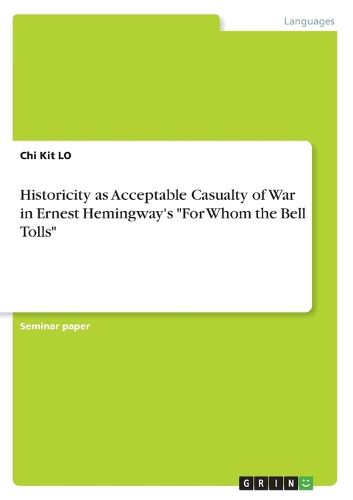Readings Newsletter
Become a Readings Member to make your shopping experience even easier.
Sign in or sign up for free!
You’re not far away from qualifying for FREE standard shipping within Australia
You’ve qualified for FREE standard shipping within Australia
The cart is loading…






Seminar paper from the year 2017 in the subject English - History of Literature, Eras, grade: NA, Simon Fraser University, course: WL309, language: English, abstract: Despite its commercial success and continued status as a postmodern classic, Hemingway’s For Whom the Bell Tolls is not without its critics when it comes to the issue of historicity and relevance to the modern reader. Harold Bloom states that among Ernest Hemingway’s many creations, only 15 of his short stories and the novel The Sun Also Rises transcend their time and exist as more than mere period pieces. Bloom implies that in his opinion, For Whom the Bell Tolls’ aesthetic and intellectual value provides the modern reader with no insight into the human condition beyond that of the Spanish Civil War temporal space. Some critics such as Dwight Macdonald even attack the novel’s historicity, accusing Hemingway of masquerading Stalinist propaganda as historical fiction. Through dissecting the series of events faced by Robert Jordan in For Whom the Bell Tolls and fact checking them against historical records of the Spanish Civil War, this essay aims to dispute the historicity of the novel. Through an examination of the ethno-cultural makeup of the group the novel’s protagonist is embedded in, this essay suggests that Hemingway may be presenting an unrealistic or idealised version of the Spanish society. Thereby this essay suggests the world constructed by Hemingway may not provide us with an accurate picture of the events and general sentiment during The Spanish Civil War. However, this essay also argues against Harold Bloom’s classification of the novel as a mere period piece. This essay suggests that while the novel was set in the Spanish Civil War, the purveyance of elements such as solidarity against a common enemy, morality, vengeance, abeyance of the nature of truth in pursuit of victory enable this novel to transcend the time of The Spanish Civil War, thereby enabling the modern reader to re
$9.00 standard shipping within Australia
FREE standard shipping within Australia for orders over $100.00
Express & International shipping calculated at checkout
Stock availability can be subject to change without notice. We recommend calling the shop or contacting our online team to check availability of low stock items. Please see our Shopping Online page for more details.
Seminar paper from the year 2017 in the subject English - History of Literature, Eras, grade: NA, Simon Fraser University, course: WL309, language: English, abstract: Despite its commercial success and continued status as a postmodern classic, Hemingway’s For Whom the Bell Tolls is not without its critics when it comes to the issue of historicity and relevance to the modern reader. Harold Bloom states that among Ernest Hemingway’s many creations, only 15 of his short stories and the novel The Sun Also Rises transcend their time and exist as more than mere period pieces. Bloom implies that in his opinion, For Whom the Bell Tolls’ aesthetic and intellectual value provides the modern reader with no insight into the human condition beyond that of the Spanish Civil War temporal space. Some critics such as Dwight Macdonald even attack the novel’s historicity, accusing Hemingway of masquerading Stalinist propaganda as historical fiction. Through dissecting the series of events faced by Robert Jordan in For Whom the Bell Tolls and fact checking them against historical records of the Spanish Civil War, this essay aims to dispute the historicity of the novel. Through an examination of the ethno-cultural makeup of the group the novel’s protagonist is embedded in, this essay suggests that Hemingway may be presenting an unrealistic or idealised version of the Spanish society. Thereby this essay suggests the world constructed by Hemingway may not provide us with an accurate picture of the events and general sentiment during The Spanish Civil War. However, this essay also argues against Harold Bloom’s classification of the novel as a mere period piece. This essay suggests that while the novel was set in the Spanish Civil War, the purveyance of elements such as solidarity against a common enemy, morality, vengeance, abeyance of the nature of truth in pursuit of victory enable this novel to transcend the time of The Spanish Civil War, thereby enabling the modern reader to re